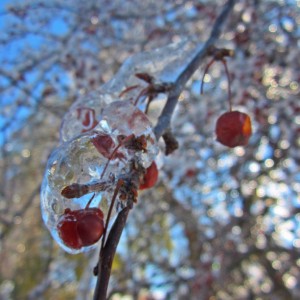 I am a gardener. Well, let me rephrase that: I like being out in my garden. I like it because it calms me to dig my hands into the dark, rich soil and to observe the changes that are constantly happening. There is a clear and noticeable rhythm in nature and I have learned a lot from this rhythm.
I am a gardener. Well, let me rephrase that: I like being out in my garden. I like it because it calms me to dig my hands into the dark, rich soil and to observe the changes that are constantly happening. There is a clear and noticeable rhythm in nature and I have learned a lot from this rhythm.
It has taught me about life, patience, and support. It has taught me that sometimes doing less is better, more supportive. It has taught me to accept the inevitable and do my best with the rest. It has taught me acceptance and how to find the gift in seemingly useless or openly annoying “pests”. And it has taught me about boundaries and limitations, both of myself and of life.
This winter my yard — Mother Nature — is teaching me again. This time the lesson is about death, life, patience, and the need to let go.
Over the past 20 months I have witnessed a lot of death, both literally and symbolically, personal and by affiliation. No matter how much spirituality there is in my life, loss and grief are still painful emotions; and the sheer amount of things ending has inspired me take a look at death and loss through new eyes. Looking out the window I seems to me that winter may have a lesson to teach us about that.
Let me share my thoughts with you:
During the winter months nature lies seemingly frozen, barren, and lifeless. The world becomes a monochrome experience of white, grey, and brown. The occasional brilliant blue and sunny sky bring hope for a while but sooner or later another grey day emerges and hope vanishes. However, hidden away from sight, deep underground, life continuous and small miracles happen.
Deep in the frozen ground seeds and bulbs, rhizomes and roots are undergoing a process of evaluation, change, and renewal. Some seeds are strong, full of life force and potential. They will be sprouting, creating new, visible life, once the sun gets higher and the frozen earth thaws out. Other seeds may be ailing, struggling with damage or disease. They may have to be mended, healed, or split in order to find enough strength to sprout again. And yet other seeds my be damaged beyond hope. They will wither away, their life force returning to the soil, ready to nourish and strengthen other seeds.
It seems to me that the grieving process is a similar journey.
For many people touched by loss — loss of a person, of health, a relationship, a way of living, a hope — the experience during the first months or years is very much like the experience of a long winter: grey, dark, frozen, seemingly barren. A few moments of light and hope may appear here and there, but often they are gone before they have been fully claimed.
But deep within the soul something else is happening: hidden from sight — and often also from our own conscious awareness — the soul is at work, preparing the heart for the next spring, for the next step in life. As we grieve and remember that which has been lost, our soul examines and evaluates the seeds of life within us, and especially those seeds that are connected to the person or situation we have lost. These seeds may be abilities, beliefs, thoughts, emotions, memories, or characteristics. Everything is under scrutiny.
Some abilities, beliefs, or characteristics that we thought to be strong and solid may turn out to be damaged beyond help by our loss. Others may turn out to be much more sturdy and rich in life force than we ever thought possible. And sometimes new thoughts, strengths, and beliefs are beginning to gather strength in times of loss.
When the ice storm hit Toronto in December of last year, I was amazed at both the destruction and the beauty it brought. Looking at some of the ice-covered buds and branches I saw how this threat of death actually enhanced the beauty of that which withstood it. Lilac buds covered in ¼ inch of ice survived; wrinkled apples left on a tree not only shone more brightly in their icy cover but when the thaw came they got soft and offered easy access to nourishment for many of the birds and critters in the neighbourhood. There was something else I realized when I surveyed the damage the ice storm left on my yard: the slow growing trees, the conifers and hardwood trees, carried the burden of the ice without much lasting damage. It was the fast growing soft-wood trees that succumbed more easily to the extra weight.
Again, it seems to me that there may be a lesson for grieving in this observation. In grief the parts of us that were filled with love, light, and life before the loss often shine even more brightly in it — and most often these parts do survive the harshness and pain of the sudden change. These are usually the qualities we have grown with patience, and often with hard work, over time. On the other hand, those qualities which we are just beginning to build or that we hastened forward, qualities that are not rooted in out own truth but in fear, shame, etc. often don’t survive the storms of loss and grief.
Every winter is followed by spring. During the inner process of testing, discarding, and nourishing we decide, consciously or subconsciously, what seeds of our souls have enough strength to be fostered and nurtured through our difficult winter. With this we also decide what parts of our “old” life (the life we lived before the loss) will follow us into and stay with us in our new life (the life that comes after loss).
It is here that integration can happen and new life becomes possible. If we give ourselves, our souls, the time it takes to honestly and respectfully sort through our feelings, memories, fears, and hopes; if we can find the courage to let go of some things that may seem important but don’t fully connect to our own inner truth any longer; if we can imagine a Self without that which was lost, then we have a chance to not only survive our loss but even flourish after it. We would then keep those memories, abilities, and characteristics that we developed in our life before loss, and that truly strengthen us. We would, in fact, keep the other, the lost, alive, giving it life beyond death, simply by living our new, integrated Selves fully and honestly.
If, however, we fail to find the courage to let go we run into the danger of getting stuck and dying to ourselves. If our grief keeps us from life; if it doesn’t allow us to let go of even one memory, one thought; if it forces us to relive the past rather than allowing us to find some life force in the present and in the presence of loss, then our soul may truly suffocate in the deep freeze of hopelessness and despair.
Winter takes its time: as we can see right now, winter won’t be hurried, no matter how much we may feel we can’t stand another day of it. Winter demands patience of us. It demands respect. It reminds us that life is precious and that we need to hold on to the memories of light, flowers, and joy during the darker times. Just like we can’t expect our gardens to come out of winter exactly as they were at the end of last summer, we can’t expect ourselves and our lives to be exactly the same after loss.
But, like our gardens, we can come through the darkness of loss with new growth, new blooms, new fruit, and renewed strength for life — and we may find that the new inner landscape that was created by our loss is more suitable to a happy and fulfilled life in our new circumstances than the one that befitted our life before the loss.

